A visit to the Isles of Scilly is the perfect away-from-it-all holiday destination. Journey across the seas to a set of low-lying islands adrift some 28 miles into the Atlantic, off the western tip of Cornwall. As you slowly slot into island life, you’ll soon be transfixed by our crystal-clear waters and altogether other worldliness.
A visit to the Isles of Scilly is like stepping into another time altogether, something so pure and simple, life somehow got easier. There are no ubiquitous chains or ram-packed beaches. These islands in the stream are a dreamlike Atlantic archipelago afloat in the mediating warmth of the Gulf Stream.
This remote, low-lying archipelago of over 140 islands (most uninhabited) – the most southwestern community in the United Kingdom – benefits from the shallow, clear turquoise waters, a Caribbean quality successfully captured by several of the resident artists and is a far cry from the mainland. And while Atlantic storms and wild seas occasionally rage around them, the island group’s climate is mild enough to support palm trees and subtropical plants year-round.
.jpg)
Image credit: Views across Bryher - Bryher Campsite
A population of 2,000 is scattered across five populated islands: St. Mary’s, Tresco, St. Martin’s, Bryher and St. Agnes. Daily work in fishing, farming, and tourism; a successful flower industry growing narcissus; artists, artisans and entrepreneurs – often a combination of all of these.
A potted history of the Isles of Scilly
The islands have been part of the Duchy of Cornwall since 1337 when it was created. Edward III established the Duchy for his son and heir, the Prince of Wales (who remains the Duke of Cornwall to this day).
It is likely that as long as 4,000 years ago, the islands were one landmass populated by the tribes of Britons (ancient Brythonic people) who also settled across Cornwall and Brittany. Various Bronze Age monuments that these people left behind are scattered across Scilly.
 952X650(1).jpg)
Image credit: Garrison sunsets, St. Mary's
The next group who left traces were the Tudors. The Isles of Scilly were considered the gateway to the English Channel and vulnerable to invasion from France and Spain. They were havens for continental pirates and smugglers as well. Besides the ruins of Tudor fortifications, Star Castle (a luxury hotel) and the Garrison Wall surrounding it were created during the reign of Queen Elizabeth I. The Spaniards and the French never invaded, but the islands saw English Civil War skirmishes in the 17th century.
Remains of these past civilizations and cultures dot every inhabited island in the archipelago. For more on the history and heritage of Scilly, visit here. All are free to visit.
.jpg)
Image credit: Deep Point, St. Mary's by Ed Marshall
Wildlife and nature
More than 140 islands and rocky islets make up the Isles of Scilly. It’s one of the largest archipelagos in the world. For the most part, these are windy, wild desert islands – only five are inhabited. Woodlands, heaths, grasslands, wetlands, dunes and rocky headlands offer a variety of habitats to explore. In the spring, Scilly is covered with wildflowers, many of them not seen anywhere else.
.jpg)
Image credit: Sunset at Lower Moors, St. Mary's by Ed Marshall
Hundreds of varieties of seabirds and migratory birds take a break from their long Atlantic journeys on Scilly – at least 520 have been spotted. Hedgehogs, bats, grey Atlantic seals and a rare local species of shrew that chuckles and twitters when it forages are the only mammals.
.jpg)
Image credit: Puffin in flight by Ed Marshall
The islands’ famous flower farms produce the earliest scented narcissi available in the UK. There is a long history of flower farming on the Isles of Scilly, and it has been a mainstay of the Scillonian economy for centuries. Today narcissi are grown commercially on four of the five inhabited islands, keeping up the long-held island tradition of producing high quality and beautifully scented narcissi for which Scilly is famous.
To find out more about wildlife on Scilly, visit the Isles of Scilly Wildlife Trust.
The inhabited islands
Each of the five inhabited islands has its own personality. It’s relatively easy to go from one to another (between 10 and 30 minutes) with inter-island boating St. Mary’s Boating Association operate a selection of boats as well as St. Agnes Boating and Tresco Boat Services who wield the channels between them. Island-hopping, whether you select one or more of the off islands, is a big part of any visit. But tides and weather can upset the most carefully drawn schedule so it’s wise to prioritise your favourites if you’re planning a short stay.
Explore all islands here.
.jpg)
Image credit: Island-hopping with the tripper boat services
ST. MARY'S
Imagine a small English town: community fuelled, embracing a simpler way of life and surrounded by the sea. A narrow neck of land rimmed with white sand beaches and dotted with stone houses joins Hugh town to the rest of the island.
This island is the commercial hub of the Isles of Scilly and the main access, by boat, to the other four. It has Scilly’s main airport receiving flights from Skybus with Isles of Scilly Travel and Penzance Helicopter from the mainland (a separate heliport on Tresco opened in 2020), and it is the port for the passenger ferry, Scillonian III which travels from Penzance in season.
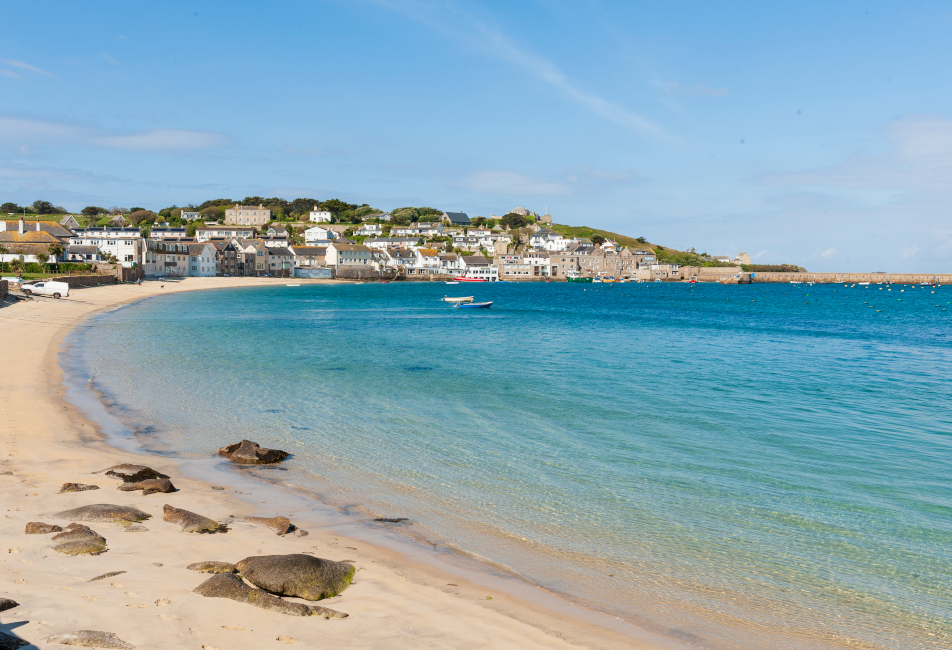
Image credit: Town Beach with views across to the quay by Nick Bond
Hugh Town, the ‘capital’, is where you’ll find the islands’ supermarket, chemist, a few independent shops, art galleries, and a small selection of pubs, restaurants and takeaway options. Occasionally a farmers’ market purveying locally grown and seasonal produce pops up (probably the smallest you’ll ever see) and food trucks bring international influences in the main season.
.jpg)
Image credit: Hugh Town, St. Mary's
The entire island is only two and a half miles long and three miles wide, covering six square miles. It has relatively level, occasionally rugged coastal walking, 30 miles of nature trails and just a few paved roads, clustered around Hugh Town.
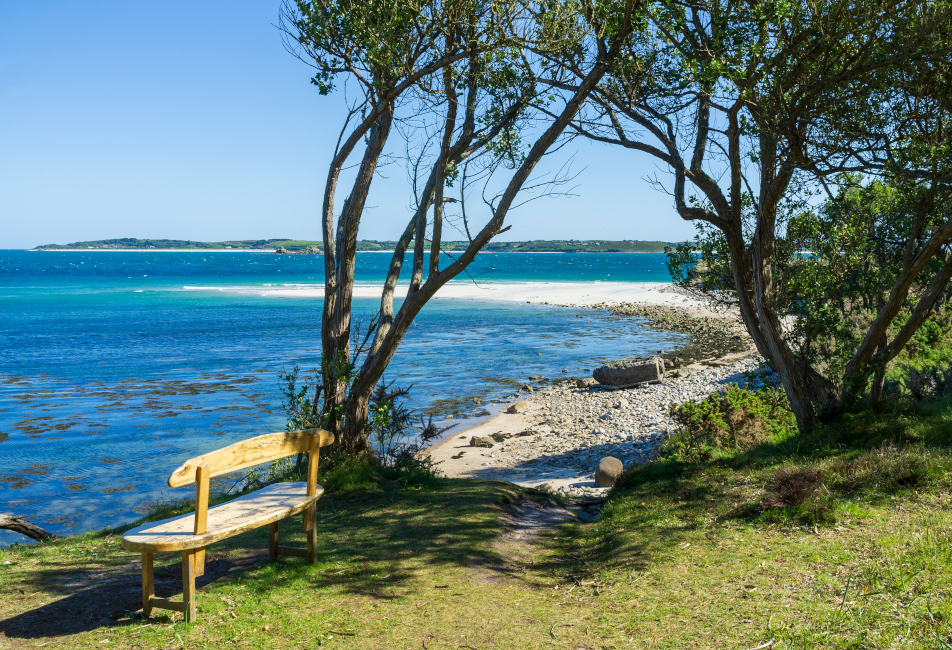
Image credit: Bar Point, St Mary's by Nick Bond
For a gentle hour’s walk pre-dinner or early morning, explore the Garrison peninsula on the south-west corner of St. Mary’s. Pass through the Garrison gateway at the harbour-end of Hugh Town and follow the path that hugs the coastline and explore the many batteries and canons on route on this circular jaunt. For a longer walk, head to the north of the island and Bar Point with it's white sweeping sands and stunning views across to Tresco.
Discover more about St. Mary’s.
ST. AGNES
St. Agnes is the southernmost community in the United Kingdom; a tiny, peaceful island. It has a watersports centre, with kayaks, paddleboards, and snorkelling, a handful of artists, Scilly’s only dairy farm and a small church with beautiful contemporary stained-glass windows by local artist Oriel Hicks.
.jpg)
Image credit: The 17th century St. Agnes Lighthouse
The Turk’s Head, the island’s only pub, is the UK’s southernmost drinking spot but the Coastguards Lookout is a favourite lunch spot for a tasty toastie and a frothy cappuccino. Situated above Santa Warna with views over the Western Rocks and Bishop Lighthouse the café has indoor and courtyard seating with island-made driftwood tables and sail awnings. The islands’ dairy farm, Troytown Farm, with its nine cows is probably the smallest dairy farm in England. It produces the island’s supply of yoghurt, milk, and incredibly rich ice cream that you can buy direct. The farm also rents holiday cottages and tents – the stunning views come for free!
.jpg)
Image credit: Ice-cream and camping at Troytown Farm by Amanda Bond
St. Agnes is encircled with a partly paved and well-maintained path, suitable for electric golf buggies or farm wagons, and not much more. Except for a short, gentle climb at the start of the path, near the dock and the pub, the path is mostly level. One of the most pleasant things to do there is to circumnavigate the place, picking wild blackberries, looking out for the enormous range of wildflowers and succulents, spotting the rare wild seabirds, trying your luck on Beady Pool in search of a 17th century bead and wandering into the island’s Pot Buoys Gallery.
GUGH
 952x650(1).jpg)
Image credit: Gugh Bar, St. Agnes
Gugh is an islet connected to St. Agnes by a sandbar at low tide, but when the sea pours over, it is an island in its own right. With back-to-back beachs, you can chose your own view! Like a lot of the Isles of Scilly, it is littered with mysterious Stone Age ruins – and only a couple of houses - populated for thousands of years. If you do decide to walk over, be aware of the tides because there is no boat service to Gugh. The nearest landfall in the opposite direction is North America, some 3,000 miles away.
Discover more about St. Agnes.
TRESCO
Tresco, second largest of the Isles of Scilly, is also the most neatly manicured. It is about 2.5 miles long and so level you can easily circumnavigate it on a brisk morning walk. The island is home to some of the most beautiful white-sand beaches in the group as well as the internationally famous Tresco Abbey Garden established in the 1830s.
The Dorrien-Smith family own the island under leasehold from the Duchy of Cornwall and have done so since 1834. At one time, Augustus Smith, founder of the family dynasty, was “Lord Proprietor” of all the Isles of Scilly. Though no longer the case, the family reside here, alongside timeshare cottages and luxury self-catering rentals. The island retains its family ethos and village-like community alongside a sense of luxurious charm and sophistication.
.jpg)
Image credit: Tresco Abbey Garden
Tresco Abbey, the family home, is a 19th-century baronial mansion named for a monastery that had existed on the island for about 1,000 years until Henry VIII dissolved it. It’s not open to the public but Tresco Abbey Garden, Smith’s most significant legacy for visitors, is. This enormous, sub-tropical paradise in a sheltered valley is part of the ancient abbey grounds.
.jpg)
Image credit: Valhalla Museum at Tresco Abbey Garden
If you do nothing else in Scilly, a day trip to the gardens with their collection of exotic South African, Australian and New Zealand plants and flowers, is a must. Landscaped terraces, crammed with delights, climb the sides of the valley, revealing surprising plants, sculptures and changing views of the island at every turn. The sound of rushing water, from artfully placed fountains and cascades, fills the air.
At the bottom of the garden, the Valhalla Museum – created by Smith in 1840 – houses a collection of figureheads and name boards from merchant vessels shipwrecked around the islands, along with their stories. There’s also a good gift shop and a comfortable place to stop for lunch or tea.
Image credit: Cromwell's Castle, Tresco
Surefooted history buffs can also make their way to several English Civil War sites managed by English Heritage. Cromwell’s Castle, built in 1651, is one of the few surviving Cromwellian fortifications in Britain. King Charles’ Castle was a small artillery fort built during the short reign of Edward VI but only manned 100 years later by Royalist followers of King Charles I.
.jpg)
Image credit: The Ruin Beach Café, Tresco Island
From the east to the west of the island, there are endless places to eat. From a traditional charming inn to Mediterranean beachfront dining and laidback brunches – you won't go hungry!
Discover more about Tresco Island.
BRYHER
Bryher is the smallest of the inhabited islands, about a mile long and half a mile wide, so it’s surprising how much variety you’ll find there. The west-facing side has a rugged shoreline with rocky bluffs facing the Atlantic at Hell Bay (which should give you some idea of its waves and currents). The island’s east side is just a few hundred yards across from Tresco. During spring tide, it is possible to walk across the sand between the two islands. As the water (regularly as much as 16 feet deep) recedes, it reveals the outline of Bronze Age settlements and field patterns.
 952X650(1).jpg)
Image credit: Watching the sunset at Hell Bay Hotel, Bryher
This tiny island is also the setting of the film "When the Whales Came", based on Michael Morpurgo's novel inspired by the island.
Whether you're exploring rocky coves, lazing on white sandy beaches, or hiking up one of its small granite hills for some great views, Bryher serves up a wonderful sense of freedom and purity. The entire island is criss-crossed by tracks and dotted with stalls selling fresh produce including delicious seafood from Island Fish and Bryher Shop is an excellent spot to purchase tasty treats everything you need for a great holiday. Camping is one of the most raw experiences to do on island; Bryher Campsite will make you feel most welcome with great views to boot.
.jpg)
Image credit: Hire a kayak from Hut 62
Hut 62 offer boat and kayaks for hire and there a number eateries, including Olivia’s Kitchen – for a light snack - and Fraggle Rock, one of Britain's smallest bars.
Discover more about Bryher.
ST. MARTIN'S
Crystal clear waters, idyllic beaches and a prevailing sense of calm make St. Martin's pretty special. With its iconic red and white Daymark, erected in 1683 by Thomas Eskins, it is the first island you spot as you cross from the mainland.
.jpg)
Image credit: The iconic Daymark on St. Martin's by Gareth Tibbs
More sandy beaches than you can shake a stick at, a vineyard, a pub, a tea shop, a Scilly-inspired jewellery designer, a bustling bakery, restorative body treatments infused with seaweed and a flower farm makes this island a pretty industrious and diverse community.
Image credit: Watersports on St. Martin's
It’s the place to go for a quiet spot of relaxation but it’s also an excellent place for wildlife experiences, like snorkelling with seals and watersports. And a relatively new, community-organized, two-domed observatory, COSMOS, is the most south-westerly observatory in the UK. There, locals, and visitors, can experience this island’s natural dark skies stargazing environment. Stargazers everywhere join Dark Skies Week every October!
Image: Great Bay, St. Martin's
Discover more about St. Martin’s.
Activities for a visit to the Isles of Scilly
For some, doing very little here is the best thing on a visit to the Isles of Scilly. A holiday here provides that rare chance for uninterrupted peace and rest, as well as a spot of mindfulness. Enjoy nature and sea views, bring a sketch pad or a camera and unleash your inner artist or simply walk your way around the islands, exploring. Stop now and then to enjoy locally grown fruit and veg, meat and dairy, as well as fish and seafood – crabs, lobsters and scallops – hauled in from local waters and accompanied by wine from vineyards on St. Mary’s and St. Martin’s.
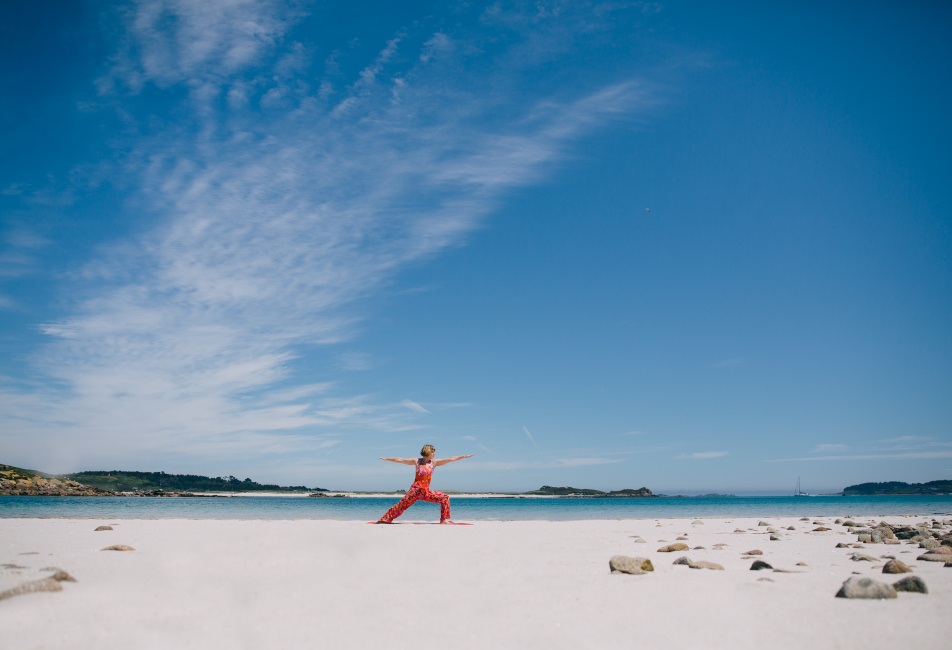
Image: Yoga on the uninhabited island of Samson
And if you like exhilarating, breath-taking experiences, take to the water for a spot of “wild swimming” with the islands’ experts either with Wild & Scilly Mermaids or Adventure Scilly. It has grown in popularity so much so there is no better place to take on your first sea swimming challenge! Don’t forget your wetsuit (or hire one) or skins for a spot of warmth. The inter-island waters are famous for scuba diving, with at least 155 identified dive sites and several dive suppliers and operators.
Scilly boating
If you’d rather get on the water than in it when you visit the Isles of Scilly, all kinds of boats – kayaks, rowboats, small powerboats, and sailboats – are available to hire from suppliers on several of the islands. Check out The Sailing Centre on St. Mary’s and Tresco. Wildlife safaris leave from St. Mary’s, St. Agnes and St. Martin’s. Chalkboards on the docks and near the St. Mary's Boatmen’s Association offices list the times and prices of boat excursions and safaris.
For more experiences, visit here.
.png)
Image credit: Excursions with Sea Quest
Plan your trip
Check out the official guide to these beautiful islands for inspiration, things to do, events, island-hopping adventures, the perfect place to stay and planning your stay by exploring more of our website here.
For boating information and queries, contact the Tourist Information Centre near Porthcressa Beach on St. Mary's.
For What’s On throughout the year click here.
How to get here
Depending upon where you start from, getting to the Isles of Scilly can be something of an adventure. You can visit the Isles of Scilly by plane, passenger ferry, or helicopter. First, you must get to one of several departure points in Cornwall (Lands’ End, Penzance and Newquay) and Devon (Exeter). Trains from London with GWR take up to five hours. Next year, the relaunch of the Night Riviera Service (Sleeper Service) from London Paddington teams up with early morning travel departures directly to the islands from Penzance and Land’s End.
Travel with Isles of Scilly Travel
Isles of Scilly Travel operates both Skybus flights and Scillonian III sailings to the Isles of Scilly. You can fly on Skybus to St. Mary’s Airport from Exeter and Newquay (seasonal) and Land’s End (year-round). The fastest, cheapest flights are from Land’s End for a 20-minute flight, with up to 21 flights a day in peak season. Flights from Newquay take 40-minutes. Spy breath-taking views of the Cornish coastline before crossing the 28 miles of water to Scilly. Skybus flights depart from Exeter from March through to October and take 60 minutes. You can take two pieces of hold luggage with a combined weight of no more than 15kg. Skybus is a dog-friendly airline and pets can travel in a crate next to you (book early).
.jpg)
Image credit: Western Rocks Café at Land's End Airport and Skybus
Alternatively, you can sail to the islands onboard Scillonian III passenger ferry. Scillonian III sails between Penzance and St. Mary’s from March to November. A perfect way to travel with your four-legged friends on this two-hour and 45-minute sailing.
 Scillonian use 952X650(2).jpg)
Image credit: Scillonian III passenger ferry, Isles of Scilly Travel
Visit islesofscilly-travel.co.uk or call 01736 334220 to find out more.
Travel with Penzance Helicopters
Helicopter flights to the Isles of Scilly take just 15 mins direct to St. Mary’s or Tresco Island and are available through Penzance Helicopters all-year-round from Penzance Heliport. There is a car park on site and the Train Station is a good 20 min walk or quick journey in the electric shuttle bus. Passengers can check in one item of luggage (up to 20kg per person) in the hold (infants is less). Carry-on is limited to one small piece - a coat or a handbag, for example. Dogs welcome on board.
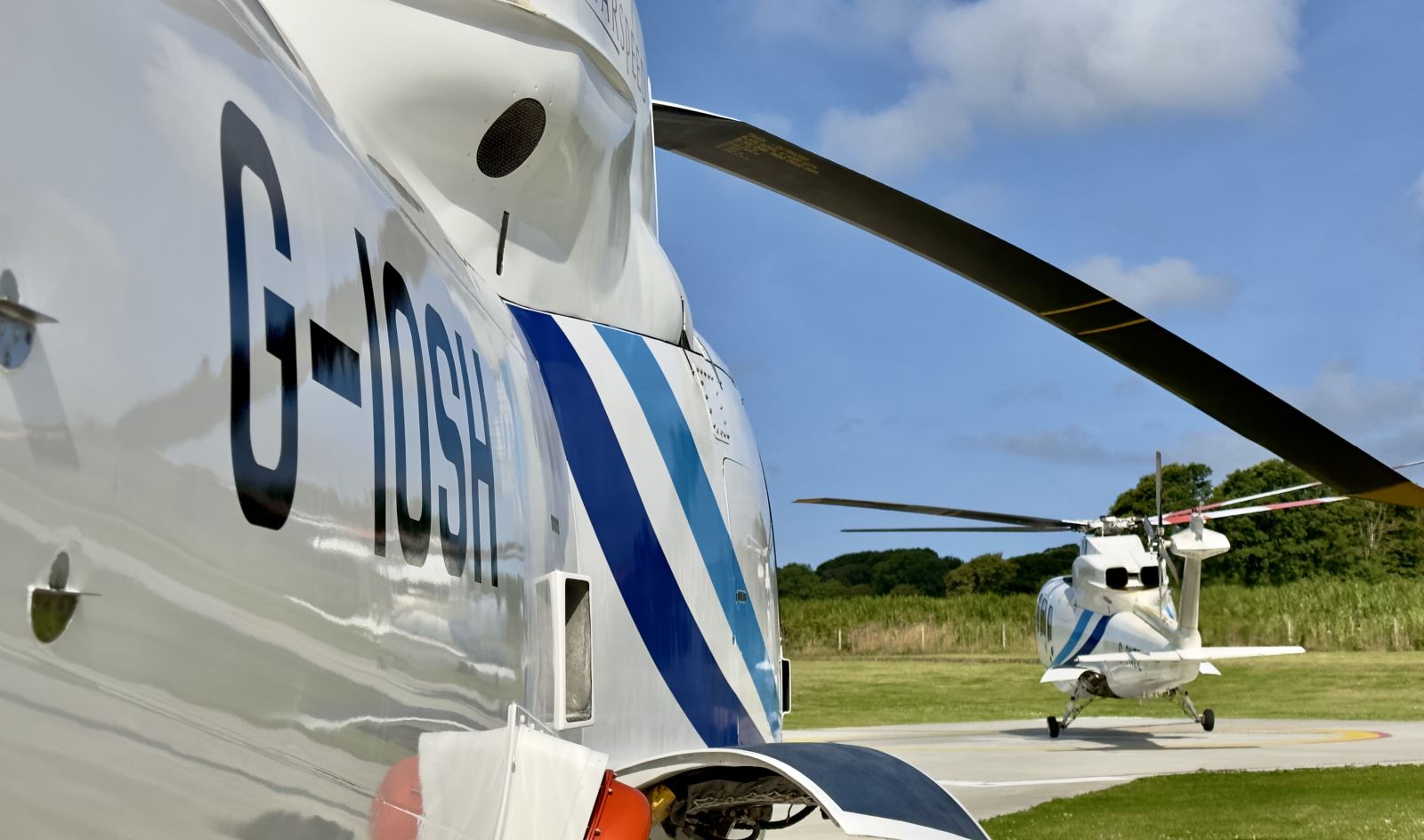
Image credit: Penzance Helicopters at Penzance Heliport
Visit penzancehelicopters.co.uk or call +44 (0)1736 780828
For more travel information, visit here.
Where to stay
There is a fair range of accommodation types across the islands – from converted barns, castles, camping and self-catering units with a range of options to suit every taste and budget. Many take dogs, offer ground-floor and family rooms, as well as all the mod cons. All properties must be accredited to meet industry ‘safe, legal and clean’. Several properties are also recognised by Green Tourism for their efforts to reduce environmental impact.
.jpg)
Image: Cottage on Tresco Island
Check out places to stay here.
If you are visiting Tresco, choose from a cottage, apartment, or stay in The New Inn. See tresco.co.uk/staying for more details.
Getting around
Visitors are not allowed to bring cars to the islands, and most people who visit the Isles of Scilly get around on foot, by bicycle (St. Mary’s Bike Hire or Tresco Bike Hire) or on electric golf carts (Scilly Carts) that can be rented on St. Mary’s, the biggest island. There are taxi services, airport, and hotel shuttle buses, as well as cars owned by locals on St. Mary’s. On Tresco you’ll occasionally see little green electric Tresco Estate service vehicles whizzing around.
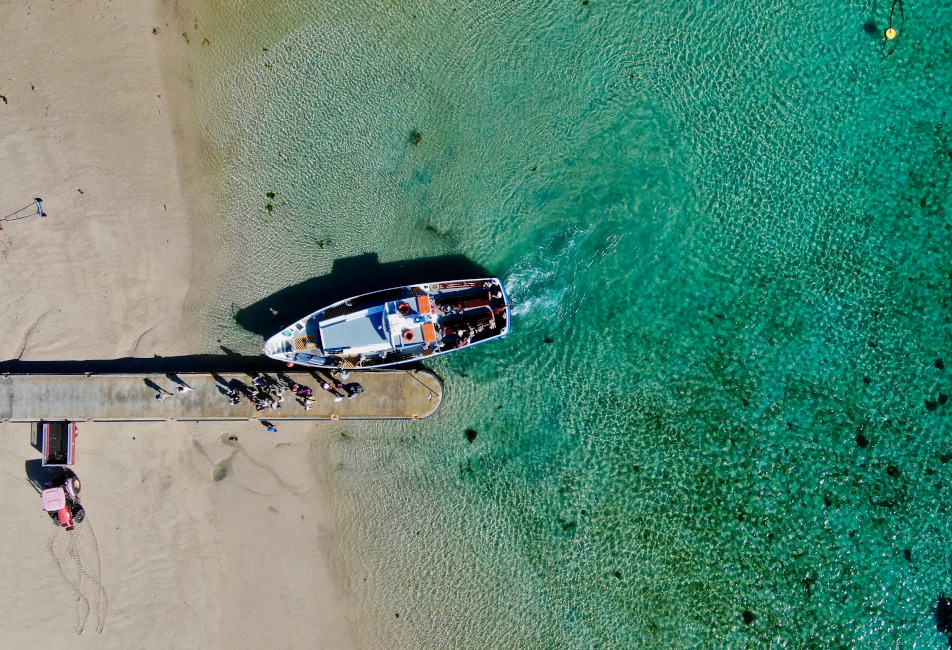
Image credit: Island-hopping with the local tripper boats by Gareth Tibbs
All the islands are connected by boat services, with small motorboats travelling between them several times a day. St. Mary’s Boatmen’s Association run the boats on the different islands and because travel is so dependent on tides, their schedules are usually only posted the day before. Look for them on chalkboards on the docks, in Hugh Town, and at the Tourist Information Centre at Porthcressa Beach, St. Mary's.
.jpg)
Image credit: Tresco Boat Services
Tresco Boat Services posts its next day schedule online. Both them and St. Agnes Boating coordinate with St. Mary’s to provide services to the off islands. Trips are short, just 15 to 20 minutes, and relatively inexpensive.
For the most part, the inter-island waters are calm. Sailing to St. Agnes, the southernmost island, involves crossing the main deep-water channel to the sea and some may find the swells unnerving in the small open boats. Tides wait for no one, and neither do the inter-island boats! Be at the dock at the appointed time, or you could find yourself left behind until the next high tide.
More information on getting around here.





.jpg)

















